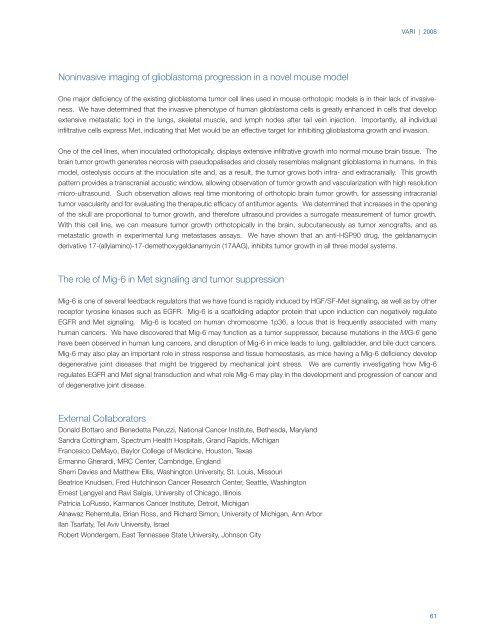2008 Scientific Report
You also want an ePaper? Increase the reach of your titles
YUMPU automatically turns print PDFs into web optimized ePapers that Google loves.
VARI | <strong>2008</strong><br />
Noninvasive imaging of glioblastoma progression in a novel mouse model<br />
One major deficiency of the existing glioblastoma tumor cell lines used in mouse orthotopic models is in their lack of invasiveness.<br />
We have determined that the invasive phenotype of human glioblastoma cells is greatly enhanced in cells that develop<br />
extensive metastatic foci in the lungs, skeletal muscle, and lymph nodes after tail vein injection. Importantly, all individual<br />
infiltrative cells express Met, indicating that Met would be an effective target for inhibiting glioblastoma growth and invasion.<br />
One of the cell lines, when inoculated orthotopically, displays extensive infiltrative growth into normal mouse brain tissue. The<br />
brain tumor growth generates necrosis with pseudopalisades and closely resembles malignant glioblastoma in humans. In this<br />
model, osteolysis occurs at the inoculation site and, as a result, the tumor grows both intra- and extracranially. This growth<br />
pattern provides a transcranial acoustic window, allowing observation of tumor growth and vascularization with high resolution<br />
micro-ultrasound. Such observation allows real time monitoring of orthotopic brain tumor growth, for assessing intracranial<br />
tumor vascularity and for evaluating the therapeutic efficacy of antitumor agents. We determined that increases in the opening<br />
of the skull are proportional to tumor growth, and therefore ultrasound provides a surrogate measurement of tumor growth.<br />
With this cell line, we can measure tumor growth orthotopically in the brain, subcutaneously as tumor xenografts, and as<br />
metastatic growth in experimental lung metastases assays. We have shown that an anti-HSP90 drug, the geldanamycin<br />
derivative 17-(allylamino)-17-demethoxygeldanamycin (17AAG), inhibits tumor growth in all three model systems.<br />
The role of Mig-6 in Met signaling and tumor suppression<br />
Mig-6 is one of several feedback regulators that we have found is rapidly induced by HGF/SF-Met signaling, as well as by other<br />
receptor tyrosine kinases such as EGFR. Mig-6 is a scaffolding adaptor protein that upon induction can negatively regulate<br />
EGFR and Met signaling. Mig-6 is located on human chromosome 1p36, a locus that is frequently associated with many<br />
human cancers. We have discovered that Mig-6 may function as a tumor suppressor, because mutations in the MIG-6 gene<br />
have been observed in human lung cancers, and disruption of Mig-6 in mice leads to lung, gallbladder, and bile duct cancers.<br />
Mig-6 may also play an important role in stress response and tissue homeostasis, as mice having a Mig-6 deficiency develop<br />
degenerative joint diseases that might be triggered by mechanical joint stress. We are currently investigating how Mig-6<br />
regulates EGFR and Met signal transduction and what role Mig-6 may play in the development and progression of cancer and<br />
of degenerative joint disease.<br />
External Collaborators<br />
Donald Bottaro and Benedetta Peruzzi, National Cancer Institute, Bethesda, Maryland<br />
Sandra Cottingham, Spectrum Health Hospitals, Grand Rapids, Michigan<br />
Francesco DeMayo, Baylor College of Medicine, Houston, Texas<br />
Ermanno Gherardi, MRC Center, Cambridge, England<br />
Sherri Davies and Matthew Ellis, Washington University, St. Louis, Missouri<br />
Beatrice Knudsen, Fred Hutchinson Cancer Research Center, Seattle, Washington<br />
Ernest Lengyel and Ravi Salgia, University of Chicago, Illinois<br />
Patricia LoRusso, Karmanos Cancer Institute, Detroit, Michigan<br />
Alnawaz Rehemtulla, Brian Ross, and Richard Simon, University of Michigan, Ann Arbor<br />
Ilan Tsarfaty, Tel Aviv University, Israel<br />
Robert Wondergem, East Tennessee State University, Johnson City<br />
61

















